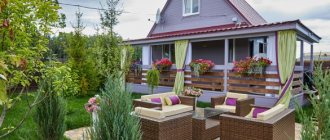Reasons for converting a non-residential building (building) into a residential one.
In fact, there are a great many reasons for converting a non-residential building into a residential building, a non-residential building into a residential building, a garden house into a residential one, and each situation is individual. We will try to highlight four main and most common groups:
- Entry into force of Federal Law 217 “On the conduct of gardening and vegetable gardening by citizens”, according to which a garden house is a building for seasonal use to satisfy citizens’ household and other needs and intended for temporary stay in it, and not for residence;
- The process of construction and installation work was delayed (for example, communications failed, etc.) and the structure, given its technical characteristics, could not be recognized as residential, but it was necessary to formalize it somehow;
- The owner's decision (there can be a great many reasons);
- A mistake made by a specialist when decorating a house.
how to correctly draw up a project for transforming a village building into a new modern home
Builders often claim that remodeling an old house is a thankless task. It’s easier to demolish a dilapidated building that has served for decades, and build a new one in its place. But is this always the solution? It turns out that even from a village hut you can make a dream mansion. There would be a desire.
Features of modernization of suburban buildings
Wooden buildings, despite positive reviews, need to be repaired. After long-term use, even a home built according to all the rules deteriorates. Selling or breaking down and then buying or rebuilding is not an option for everyone. It’s easier and cheaper to try to make a modern cottage out of an outdated house. Although even when remodeling, you need to be prepared for big expenses, the amount of which depends on the deterioration of the building. When the project involves not a partial, but a global restructuring - increasing the area, replacing the materials of walls, roofing, flooring, communications - you should prepare a tidy sum.
Also keep in mind that if the project of remodeling an old wooden house can still be done independently, then it is better to call a professional to assess the technical condition and determine the parts that must be replaced. For a competent, experienced remodeler, this is an easy task.
How to breathe new life into an old house
You can modernize a wooden house with the help of builders or yourself. If you turn the project into reality with your own hands, you can save a lot and spend the remaining money on material. It is only important to know the stages of remodeling and carry out each step in compliance with building regulations.
Stages of reconstruction of an old building
Conversion of a non-residential building into a residential one, a non-residential building into a residential building, a garden house into a residential one.
Let's start with the fact that the transfer of a non-residential building into a residential building, a non-residential building into a residential building, a garden house into a residential one is a municipal service provided by a local government body (hereinafter referred to as the “Administration”). In order to make the house suitable for living and reflect this in the documents, it is necessary to submit a corresponding application to the Administration or multifunctional). If you decide to contact the Administration directly with a transfer issue, then you need to pay attention to the exact address of the object. Since the appeal must be submitted to the Administration of the district in which the house/building is located.
Cost of work
| Services | Price |
| Visit of a specialist to the site (consultation) | 4000 rub. |
| Foundation reconstruction | from 8000 rub. per mp (work + material) |
| Roof reconstruction | from 6350 rub. per m2 (work + material) |
| Increasing the living space of the house | from 5300 rub. per m2 (work + material) |
| Extension of living space of the house | from 4000 rub. per m2 (work + material) |
| Installation of utilities | from 3450 rub. per m2 (work) |
| Interior decoration of the house | from 9200 rub. per m2 (work + material) |
| Exterior decoration of the house | from 4000 rub. per m2 (work + material) |
Documents for transferring a non-residential building into a residential one, a non-residential building into a residential building, a garden house into a residential one.
To transfer a non-residential (garden) house into a residential one, or another non-residential building into a residential one, an additional package of documents is attached to the application for transfer, namely:
- an extract from the Unified State Register of Real Estate (hereinafter referred to as “USRN”) confirming the applicant’s rights to a specific property (at the applicant’s request, since the Administration can receive this document from Rosreestr for interdepartmental cooperation). If the rights to this object have not been registered, then the title document for it (or its notarized copy);
- conclusion on the inspection of the technical condition of the object, which confirms the compliance of the object with the requirements for its reliability and safety (in accordance with the Federal Law “Technical Regulations on the Safety of Buildings and Structures”). This conclusion is issued by an individual entrepreneur or a legal entity that is a member of an SRO in the field of engineering surveys. However, such a conclusion is made exclusively on a paid basis, when concluding an agreement for the provision of such services;
- notarized consent of third parties for translation (if the object is burdened with the rights of third parties).
Briefly about the main thing
Federal Law 217-FZ, in force since January 1, 2021, abolished the concept of “dacha plot” and now there are only two categories of land: garden and vegetable plots.
You can grow crops for your own needs in both garden and vegetable plots. But if it is allowed to build houses for permanent and seasonal residence on garden plots, then only outbuildings for storing equipment or crops are allowed on garden plots.
If there is already a properly registered building on the garden plot, then the rights to it are retained.
You can always find out more at a consultation at the Moscow Regional BTI.
News source: website of the Moscow Regional BTI – mobti.ru
Ratings 0
Entering information about the transfer of a non-residential building into a residential one in Rosreestr. Procedure and deadlines.
The administration recognizes a non-residential building as residential within 45 days (according to regulations). Within 3 days, such a decision must be sent to the applicant in the manner specified in the transfer application.
As soon as the decision to transfer falls into your hands, you need to make the appropriate changes to Rosreestr.
To do this, simply contact Rosreestr with an application and attach to it a positive decision of the Administration on the transfer of a non-residential building to a residential one. There is no fee for this procedure.
If for the purpose of transfer work was carried out on remodeling/reconstruction of the house, then it may additionally be necessary to prepare a technical plan for the house (a specialist in your region will help you choose an online cadastral work calculator). In addition, the technical plan will also need to be accompanied by an acceptance committee report on the completion of the redevelopment/reconstruction (read about how to approve the redevelopment/reconstruction here).
Underwater rocks
In order for the transfer procedure to go smoothly, you need to remember the following important points:
- A cadastral engineer must work for a company that is part of an SRO for engineering surveys. If you contact a specialist who does not have such status, the documents will be considered invalid. The applicant will be denied the procedure.
- If the USRN does not reflect information about ownership, other title documents must be available. Also, all owners must agree to transfer the premises to residential use.
- There may be difficulties with preparing documents. You will need to contact a lawyer who will tell you the list of required papers and help you draw up an application.
Administrative and judicial procedure for transferring a non-residential building into a residential one
By and large, the procedure for converting a non-residential building into a residential one is quite simple. However, we all understand that each specific case may have its own nuances, which may increase costs, both time and financial. In this case, it is worth taking into account the Administration’s comments and following their recommendations, because in the event of a refusal to transfer administratively, the only way will be to go to court, and this is a completely different story, although it is also in demand.
What are the benefits and opportunities?
As already mentioned, the main opportunity for owners who have converted their dacha into a private home is to acquire the right to permanent registration. In this case, living in such a building will be legal.
Note! According to Law No. 5242-1, a citizen is required to register at his place of permanent or temporary residence.
Failure to comply with registration rules entails the imposition of penalties from 2 to 3 thousand rubles. The norms of Article 19.15.1 of the Code of Administrative Offenses of the Russian Federation apply here.
But timely registration for an indefinite period gives a person the following opportunities:
- Receiving medical care at your place of residence.
- Employment opportunity.
- Preparation of documents (TIN, SNILS).
- Receiving social services.
- Registration of a child in a kindergarten, school or other institution.
In addition, it is at the place of registration that a citizen can apply for the benefits entitled to him, for example:
- Benefits for housing and communal services.
- Tax benefits (on property, on land).
- Gasification privileges.
Basically, the listed types of subsidies are provided to pensioners, persons with disabilities, large families, and labor veterans.
Note! You can find out more about benefits at the social security office at the location of the dacha after completing the registration procedure. You can also consult your local administration.
And, of course, we should not forget that living outside the city in itself provides the opportunity for privacy, being in silence and in the fresh air. This way of life not only helps to improve physical well-being, but also acts as a sedative.
The main factors for recognizing a home as safe:
- Load-bearing and enclosing structures must be in equally good condition.
- Movement around the premises should not pose a danger, and engineering networks and systems must be installed at a high level and comply with sanitary and hygienic standards.
- All communications must be provided in a residential building: electricity, gas, water (hot and cold, suitable for drinking), heating, ventilation.
- The foundation must protect against all types of water.
- Compliance with fire safety requirements.
- The height and area of the building must comply with current standards, taking into account the area of location.
- All rooms, as well as the kitchen, should have a source of natural light.
Based on the results of consideration of your application and other listed documents, a decision is made to recognize or refuse to recognize the garden house as residential .
If you refuse to recognize the premises as residential, you can:
- Eliminate the reasons for the refusal and resubmit the documents.
- If you think that the refusal was illegal, go to court.
After the garden house is recognized as residential, you can register in it.
Service for converting a garden house into residential status on the government services website
Go
The scale of perestroika
Most dachas from the late Soviet and early post-Soviet periods are well enough preserved to survive reconstruction. When assessing a dacha building, a sequential inspection of all parts of the structure is carried out:
- Foundation . The type and depth of the foundation is determined, and at the same time it is useful to assess the composition of the soil and the groundwater level. Cracks in the foundation can be caused by various reasons and reinforcement of the foundation should be carried out depending on the reasons for their occurrence. If the cause is seasonal soil shift (with freezing and thawing of the top layer), you can limit yourself to constructing a blind area. It will protect the soil next to the foundation from freezing, preventing it from moving.
The sad state of the foundation of a wooden dacha Source plotnikov-pub.ru
- Floor . Old country houses usually stand on a simple columnar foundation; the floor and joists are located close to the ground; The structure is poorly insulated and affected by mold. Such a surface, uneven, with dried out “walking” boards, is a significant source of heat loss and must be replaced.
- Walls and roof . During the inspection, the condition of the structures is assessed, the type of material and insulation is specified. The integrity of the roof is checked.
- Communications . Most suburban buildings do not have running water or a bathroom, and bottled gas is used in the kitchen. To make country life comfortable, you need an equipped bathroom, cold and hot water, new electrical wiring and uninterrupted heating.
The first stage is a complete replacement of the foundation of a wooden house Source rubankom.com
Planning
Remodeling of the house and roof in a country house is carried out on the basis of a plan. The necessary work is determined after inspecting the building, including possible points:
- Foundation . Reconstruction starts with strengthening the foundation. First, a blind area is built, then the cracks in the foundation are sealed. If the cause of cracks is not soil freezing, but excessive load on the structure, serious strengthening of the foundation will be required. In this case, a trench is dug around the perimeter and the foundation is expanded with cement or concrete with mandatory reinforcement.
- Roof . If necessary, the rafter system is strengthened, damaged fragments are replaced with new ones. Wooden parts are treated with fire retardant and antiseptic; the roof is insulated and re-covered. The slate typical for old houses is dismantled; Instead, metal tiles or other selected material are laid. When changing the roofing covering, take into account that natural tiles require reinforcement of the rafter system, and for bituminous material a continuous sheathing is required.
An ancient dacha needs restoration and reconstruction Source plotnikov-pub.ru
See also: Catalog of companies that specialize in the reconstruction and reconstruction of houses.
- Attic . Converting an uninhabited attic into a comfortable living space is a rather expensive, but worthwhile undertaking. To do this, the ceiling is insulated (the floor of the attic and at the same time the ceiling of the living space); Up to 30% of heat loss occurs through an uninsulated ceiling. Then the roof is insulated, and often sloping windows are installed in the roof, adding light and style to the room.
- Communications . Water supply is being installed and gas is being supplied. If there is no possibility of connecting to the main networks, an alternative is developed - a well or well is dug, a septic tank is installed. To supply the house with fuel, they use gas from a gas holder or install equipment for another type of fuel. The electrical wiring needs to be completely replaced, it is installed taking into account future energy consumption.
- Walls . The facade will require insulation; old windows and doors are replaced with modern designs that can further reduce heat loss in the house.
Addition to the second floor of a wooden dacha Source famire.ru
- Bathroom . An important element of a comfortable life, for which it is necessary to install cold and hot water and sewerage. The price will include laying tiles and replacing plumbing fixtures - at a minimum, a sink, toilet and bathtub (sometimes the bathtub is replaced with a shower).
Usable area: how to add
The issue of increasing the living space is being considered separately, and different options are being considered: building an extension, expanding the veranda and completing the attic or second floor. To turn the dacha into a full-fledged residential building, a detailed layout is developed; At the same time, it would be good to take into account the possibility of periodic appearance of guests and relatives. If possible, you should not change the layout of the house or move load-bearing walls, as this will require approval in the design documents.
Country question. Is it possible to convert country houses into residential ones?
Country question. Is it possible to convert country houses into residential ones?
Permission to transfer garden houses to residential status is an important step towards not only avid gardeners, but also those who, with the help of a summer house, want to solve their housing problem.
Residents of the country received such permission two years ago, when the Constitutional Court of the Russian Federation gave the green light to register citizens in garden houses. Until this moment, registration at a dacha was prohibited by the Federal Law “On gardening, gardening, dacha non-profit associations of citizens” dated April 15, 1998. The court recognized that this ban contradicts the Constitution of the Russian Federation. Thus, Russians had the opportunity to build full-fledged houses on garden plots and register in them. However, in order to do this, several important conditions must be met; they relate to the land and the characteristics of the building itself.
Earth
Country real estate is much cheaper than those houses that are not initially built on the territory of gardening associations. This is due to the price of plots for construction. Until 2008, full-fledged houses could only be built on lands located within the administrative boundaries of settlements. Moreover, such plots must have a certain permitted type of use - housing construction. And garden houses are located on agricultural lands with another permitted type of use - summer cottage construction or farming. These plots are much cheaper. Objects built on agricultural land that has any other purpose cannot become residential buildings.
House
Only a building that meets clearly defined parameters can be recognized as residential. They are indicated in Russian Government Decree No. 47 of January 28, 2006. This document specifies general points relating mainly to the safety and minimum level of comfort of people living in the building. The standards for giving a building residential status are contained in SNiP.
In general, only those houses that:
– include a mandatory set of premises, such as a living room, kitchen, bathroom and shower room, restroom; At the same time, there are clearly established minimum sizes for these parts of the house, they are determined taking into account the arrangement of furniture and equipment: for example, a common living room should be at least 12 sq.m, a bedroom - 8 sq.m, a kitchen - 6 sq.m, ceiling height for the Ural region should be at least 2.5 m;
– have all kinds of communications: heating, ventilation, water supply, sewerage, electricity systems;
– contain premises that meet fire safety requirements, sanitary and hygienic, environmental and other legal standards.
According to experts, if a house was erected by professional builders according to an approved project, then there are no problems with recognizing it as residential, i.e. suitable not for seasonal, but for permanent use, will not arise. This is due to the fact that BTI, as a rule, does not have any special requirements for such objects. If the enclosing structures comply with the standards and there are utility networks, then the issue will be resolved positively.
To register a house as a residential one, a registration certificate drawn up by BTI employees will be sufficient. Also, do not forget about the “dacha amnesty” extended until 2015, which in many cases allows you to register housing without going to court.
However, in some situations it is impossible to do without construction and technical expertise. It can be carried out in two ways. Firstly, the homeowner by law has the right to contact specialists from the housing commission. Secondly, a house can be recognized as residential by a court decision. However, using the first method is very problematic, because Housing commissions under local governments do not exist in all cities of the country. And where they do work, you will have to wait a long time - there are a lot of people who want to resort to their services. Lawyers recommend applying to the court of general jurisdiction at the location of the house. You will need to write an application to establish the legal fact of recognizing the residential building as suitable for permanent residence. To do this, you should apply for the appointment of a construction expert, on the basis of which the court will make a decision. If it is positive, then the house will be recognized as residential.
Documentation
In order to convert a dacha building into a residential building, the owner (or a person authorized by him) must provide a number of documents to the local administration or other body that carries out the transfer of premises. The list of required papers includes:
– application for transfer of premises;
– title documents for the premises being transferred – original or notarized copies;
– a plan of the transferred premises with a declaration, i.e. technical description;
– if reconstruction or redevelopment is required to give the house residential status, then a project for these works will be needed, which must be prepared and executed in the prescribed manner.
Transfer procedure
After the documents are collected and submitted to the appropriate authority, you need to wait 45 days. During this time, a decision must be made on transfer or refusal of transfer. After the decision is made, within three working days the applicant must be given a notification confirming the fact that a positive (or negative) decision on the transfer has been made. Having received this document, the applicant must reissue the registration certificate for the house and feel free to go register it. By the way, the local government body, within the same three days after the decision is made, is obliged to inform the owners of the premises adjacent to the house being transferred.
Registration
Often the transfer of a country house to a residential one is dictated by the fact that people solve their housing problems in this way, for example, they give a city apartment to their children, and they themselves move to the country house. And some people simply prefer to live outside the city and buy cheaper housing. Today, such options are quite acceptable, since the law allows the conversion of houses into residential ones, and the infrastructure of many gardening partnerships is not inferior to the communications of residential villages. In addition, there are food stores on the territory of most dacha cooperatives. All this awakens in many Russians the desire to settle in a dacha. But in such cases, converting a house into a residential one will not be enough; registration will also be required. It is carried out at the regional migration service at the location of the housing. To register in a former country house, in addition to papers confirming the status of the house, you must provide an application, documents on the ownership of the object, a BTI registration certificate, as well as documents confirming the ownership of the land.
About the “dacha amnesty”
Of course, converting a garden house into a residential one and registering there is only possible if the building and the land under it are owned. Otherwise, it will not be possible to finally resolve the dacha issue. Now it is possible to register ownership of land plots and houses, bathhouses and other buildings built on them in a simplified manner. This procedure was called the “dacha amnesty.” It began on September 1, 2006 and was supposed to end on January 1, 2010. But its validity period was extended until March 1, 2015.
The “dacha amnesty” covers land plots provided before the entry into force of the Land Code of the Russian Federation, i.e. until October 29, 2001, for personal, dacha farming, vegetable gardening, gardening, individual garage or individual housing construction on the right of ownership, lifelong inheritable possession or permanent (indefinite) use, etc.
To register ownership of a plot of land, you need to provide the registration authorities with a title document for the land plot, a cadastral passport, a receipt for payment of state duty and an application for registration of ownership.
To register a house, you need a cadastral passport of an individual housing construction project, which is filled out by the BTI authority, and a title document for the land plot.
Since 2010, using a simplified system for registering ownership rights to garden plots and houses has become even easier. Now Russians are allowed to send documents by mail. True, only a few have resorted to the innovation so far. The low popularity of postal services here is due to the fact that people are afraid to part with original documents. In addition, the signature on such correspondence must be certified by a notary, and this implies additional financial expenses.
If all the documents are collected, you can be almost completely sure that the garden house will be registered as property. According to statistics, today in the country the percentage of refusals to register rights under the “dacha amnesty” does not exceed 1%.
According to Rosreestr, since the beginning of this law, over 6 million owners of garden plots have taken advantage of their right to a simplified procedure for registering objects, i.e. almost every third summer resident. People most actively use the “dacha amnesty” in Bashkiria, Tatarstan, Stavropol Territory, Moscow and Chelyabinsk regions.
Galina Lukashina
№ 38 (309)
All articles "
Where to begin?
First of all, you need to analyze what you have. The amount of work to be done depends on the condition of the country house and land.
Most old-type buildings lack gas, running water, sewerage, television and the Internet. It is worth assessing the state of communications and planning work in this area separately.
You will live in the house throughout the entire calendar year. Therefore, it is important to take care of the insulation of walls, windows, doors and roofs.
If you are not satisfied with the internal layout of your cottage, you will have to coordinate individual changes with the architectural and construction inspection. No approval is required when installing a boiler, plumbing or installing landscaping elements such as a gazebo, outdoor shower or garage.
When the owner of a dacha decides to thoroughly approach the renovation of a building for permanent residence, it is important to adhere to the following algorithm of actions:
- First, work is carried out to strengthen the foundation so that it can withstand the load of stronger, insulated walls;
- Then external insulation of the walls and roof is installed;
- The necessary communications are laid and connected;
- Exterior finishing work is being carried out;
- Then they move on to creating favorable and comfortable conditions directly in the house.
Redevelopment and repairs can be done inside the building. Old finishing material is removed, new electrical wiring is made, old unnecessary furniture is removed. Finishing work is carried out in a classic sequence, taking into account all the aesthetic wishes of the owners.
How can our lawyers help you? Service price
- We handle turnkey business;
- We draw up documents and tell you where you can get them, where to apply and how to proceed;
- We engage a professional expert; our examinations have never been submitted to trial or rejected in court;
- We will prepare an application and collect the entire package of documents;
- We transfer documents to the administration;
- If the administration refused us, then we make full preparations for the trial;
- We protect your interests in court. If necessary, we will appeal an unfair court decision;
- Receipt of a court decision and delivery of a writ of execution to you.
We always work under a contract and immediately explain all the terms of cooperation.
The turnkey service price is 30,000 rubles.
Call now and find out how quickly and most importantly, correctly convert a house into a residential one.
Advantages of residential status
The most noticeable “advantages” that encourage you to deal with bureaucratic paperwork are the following:
- Ownership of real estate. Private residential property is an enviable property. It is sold, donated, rented and even accepted as collateral when applying for a mortgage.
- The appearance of housing with an address. You can live in such a building not only actually, but also legally: get official registration.
- Saving money. When moving to this high rank, a tax deduction refund is issued for previously paid tax, personal income tax. And in case of switching to a rural tariff, the “electric” payment is reduced by a third.
You can’t argue with such benefits, but don’t rush to run to the administration to transfer your beloved “dacharka” to the housing stock: she must “comply”.











